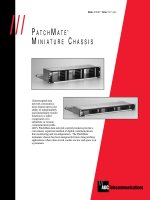Tài liệu Reflexive Access Lists pptx
Bạn đang xem bản rút gọn của tài liệu. Xem và tải ngay bản đầy đủ của tài liệu tại đây (22.84 KB, 2 trang )
1 - 2 Semester 5: Advanced Routing v2.0 - Lab 10.7.2 Copyright 2001, Cisco Systems, Inc.
10.7.2 Reflexive Access Lists
Internet
S0/0
192.168.1.1 /24
S0/0
192.168.1.2 /24
Lo0 172.16.1.1 /24
Firewall
Host A
10.0.0.11 /8
SanJose1
Fa0/0
10.0.0.1 /8
Vista
ISP Router
Objective
In this lab, you configure a reflexive access list to implement IP session filtering.
Scenario
International Travel Agency (ITA) wants you to beef up security for its network 10.0.0.0/8.
The company would like users on the 10.0.0.0/8 network to be able to establish sessions
with remote hosts at will. At the same time, the company requires that you prevent
outside sources from initiating a session. In other words, outside hosts should be able to
talk to 10.0.0.0/8 hosts only if the 10.0.0.0/8 hosts started the conversation. You need to
use a reflexive access list to implement this requirement.
Step 1
Build and configure the network according to the diagram; do not configure a routing
protocol. The loopback interface on Vista will simulate an external network.
Use ping to test connectivity between directly connected neighbors. Note that Host A
should not yet be able to ping Vista’s loopback interface.
2 - 2 Semester 5: Advanced Routing v2.0 - Lab 10.7.2 Copyright 2001, Cisco Systems, Inc.
Step 2
Configure SanJose1 and Vista for static routing. ITA uses static routes to reach the
outside world. Issue the following command:
SanJose1(config)#ip route 0.0.0.0 0.0.0.0 192.168.1.1
On the ISP’s router (Vista), you must also configure a static route:
Vista(config)#ip route 10.0.0.0 255.0.0.0 192.168.1.2
When your static routes are configured, verify that Host A can ping Vista’s loopback
interface (172.16.1.1/24). Troubleshoot, as necessary.
Step 3
Configure SanJose1 to perform IP session filtering. Configure a reflexive access list, as
shown:
SanJose1(config)#ip access-list extended FILTER-IN
SanJose1(config-ext-nacl)#permit ip any any reflect GOODGUYS
SanJose1(config-ext-nacl)#exit
SanJose1(config)#ip access-list extended FILTER-OUT
SanJose1(config-ext-nacl)#evaluate GOODGUYS
SanJose1(config-ext-nacl)#exit
SanJose1(config)#int e0
SanJose1(config-if)#ip access-group FILTER-IN in
SanJose1(config-if)#ip access-group FILTER-OUT out
These commands create two named access lists, FILTER-IN and FILTER-OUT. The
FILTER-IN list monitors packet data as it is sent from a host into the E0 interface. The
data is captured and put into a temporary list called GOODGUYS. The FILTER-OUT list
looks at the data stored in GOODGUYS and monitors TCP/IP traffic being delivered out
the E0 interface. Any TCP/IP traffic that originated from the 10.0.0.0 network is allowed to
come back into the network.
Step 4
1. From Vista, ping the 10.0.0.11 host. At this point, Vista should not be able to ping
10.0.0.11. Why?
From Host A, ping Vista’s loopback interface, 172.16.1.1. This ping should be
successful.









